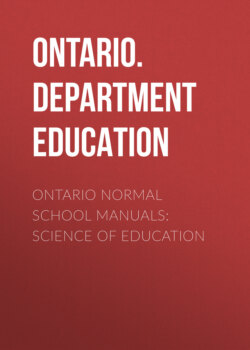Читать книгу Ontario Normal School Manuals: Science of Education - Ontario. Department of Education - Страница 46
THE LESSON PROBLEM
ОглавлениеProblem, a Motive.—The foregoing description and examples of the educative process have shown that new knowledge necessarily results whenever the mind faces a difficulty, or need, and adjusts itself thereto. In other words, knowledge is found to possess a practical value and to arise as man faces the difficulties, or problems, with which he is confronted. The basis of conscious activity in any direction is, therefore, a feeling of need. If one analyses any of his conscious acts, he will find that the motive is the satisfaction of some desire which he more or less consciously feels. The workman exerts himself at his labour because he feels the need of satisfying his artistic sense or of supplying the necessities of those who are dependent upon him; the teacher prepares the lessons he has to present and puts forth effort to teach them successfully, because he feels the need of educating the pupils committed to his care; the physician observes symptoms closely and consults authorities carefully, because he feels the need of curing his patients; the lawyer masters every detail of the case he is pleading, because he feels the need of protecting the interests of his client. What is true of adults is equally true of children in school. The pupil puts forth effort in school work because he feels that this work is meeting some of his needs.
Nature of Problem.—It is not to be assumed, however, that the only problem which will prompt the individual to put forth conscious effort must be a purely physical need, such as hunger, thirst, or a distinct desire for the attainment of a definite object, as to avoid danger or to secure financial gain or personal pleasure. Nor is it to be understood that the learner always clearly formulates the problem in his own mind. Indeed, as will be seen more fully later, one very important motive for mastering a presented problem is the instinct of curiosity. As an example of such may be noted a case which came under the observation of the writer, where the curiosity of a small child was aroused through the sight of a mud-turtle crawling along a walk. After a few moments of intense investigation, he cried to those standing by, "Come and see the bug in the basket." Here, evidently, the child's curiosity gave the strange appearance sufficient value to cause him to make it an object of study. Impelled by this feeling, he must have selected ideas from his former experience (bug—crawling thing; basket—incasing thing), which seemed of value in interpreting the unknown presentation. Finally by focusing these upon this strange object, he formed an idea, or mental picture, which gave him a reasonable control over the new vague presentation. Such a motive as curiosity may not imply to the same degree as some others a personal need, nor does it mean that the child consciously says to himself that this new material or activity is satisfying a specific need, but in some vague way he knows that it appeals to him because of its attractiveness in itself or because of its relation to some other attractive object. In brief, it interests him, and thus creates a tendency on the part of an individual to give it his attention. In such situations, therefore, the learner evidently feels to a greater or less degree a necessity, or a practical need, for solving the problem before him.
